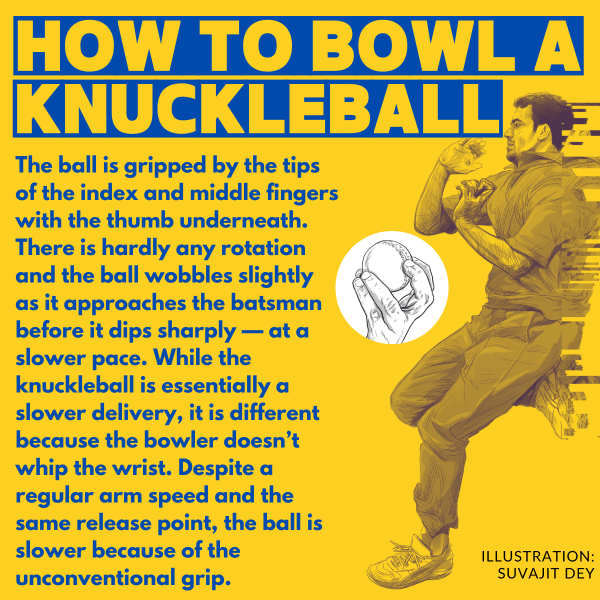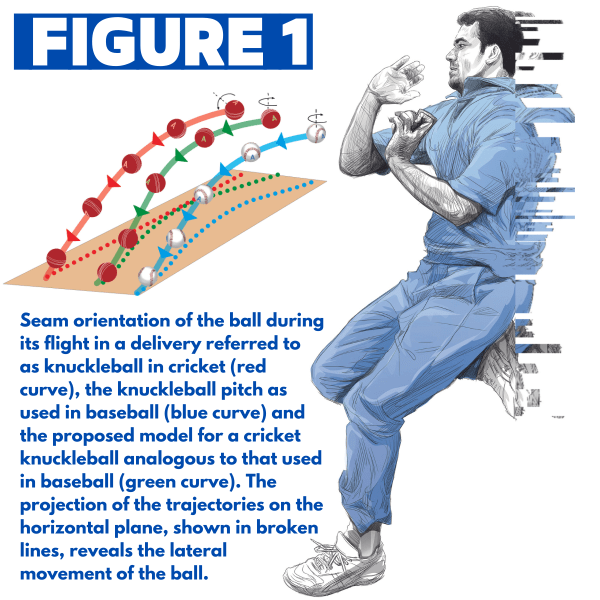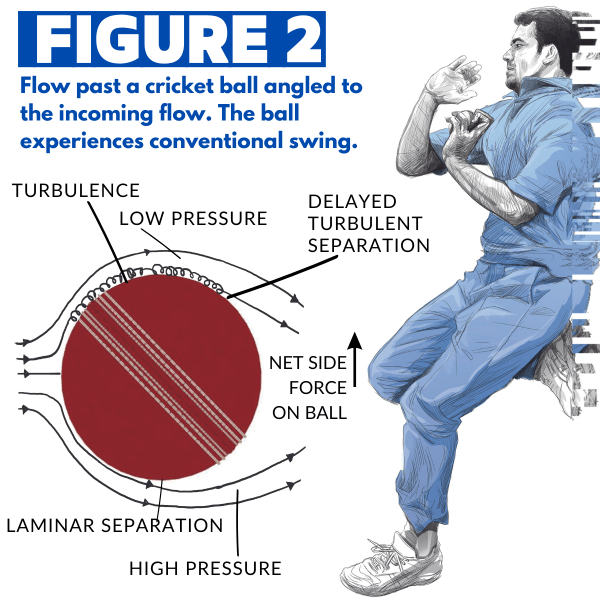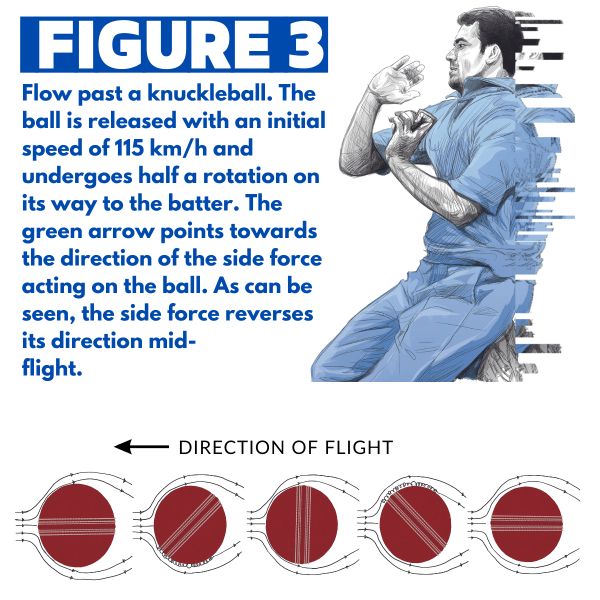With advancing bat technology, ever-shrinking boundaries, and the constantly evolving stroke play of modern batters, bowlers today face the uphill task of constantly enhancing their repertoire to keep up with the rapidly changing nature of the game. Among the popular variations used by the bowler is knuckleball.
Back in 2010 during the IPL, Indian pacer Zaheer Khan had coaxed South African pacer Charl Langeveldt to share the secret of the ball that floats, wobbles and finally dips towards the stumps. Other reputed Indian pacers, Ishant Sharma and Bhuvneshwar Kumar, would later make the knuckleball an important weapon in their battle against big strokemakers.

Despite borrowing its name from a baseball pitch, cricket’s knuckleball has a different flight and trajectory. Bowled with minimum spin, baseball’s ‘knuckleball pitch’, while in flight, changes the lateral direction multiple times. The unpredictable zigzag trajectory of these pitches makes them one of the hardest pitches to hit in baseball. Even in football when the the ball is kicked with minimal spin, it also exhibit similar erratic trajectories in the air. The blue curve in Fig. 1 (below) shows the trajectory of a typical knuckleball in baseball.
On the other hand, a knuckleball in cricket in its present form is primarily used as a change of pace delivery. The phenomenon of “breaking”, or changing of the lateral direction of flight in the air, is not observed with a knuckleball in cricket. Cricket bowlers often lend a topspin to the ball while bowling a knuckleball. As shown in the red curve in Fig. 1, such a delivery does not undergo lateral deflection in the air.
Baseball and cricket, however, are closely related sports. For example, the phenomenon of “seam shifted wake” in baseball has similarities with swing bowling in cricket. This naturally leads us to explore the possibility of having baseball-like knuckleball in cricket.

In order to explore this possibility, it is important to first understand why a cricket ball traveling through the air moves laterally at all. A cricket ball experiences a lateral aerodynamic force if the air flows over it asymmetrically.
Such an asymmetry in the flow can be created in multiple ways: like bowling with an angled seam, maintaining different surface roughness on the two halves of the ball, or imparting to it a rotation about an axis perpendicular to its motion.
Relevant to this discussion is the case of bowling with an angled seam. When a fast bowler bowls with a seam angled towards or away from the batter, the side over which the flow encounters the seam first creates a disturbance in the flow. As a result, the thin layer of air over the surface of the ball – known as the boundary layer – transitions to an unsteady chaotic state, known as turbulence, over this side of the ball.
The flow over the other side, unperturbed by the seam, remains smooth and steady, and is known as laminar flow. The laminar boundary layer “separates” from the surface of the ball at some point. Owing to its increased energy, the turbulent boundary layer remains attached to the surface longer than the laminar boundary layer. A delayed point of separation is associated with low pressure and thus the ball experiences a side force towards this side. This is the mechanism behind the phenomenon of conventional swing and the reason why a new cricket ball swings towards the seam side of the ball at low speeds. A force towards the slips results in an outswinger and a force towards the pads an inswinger.
Owing to its saddle-shaped stitching, it is common for knuckleball pitchers to impart very low spin to baseball about its direction of motion, known as “gyrospin”, to achieve flow asymmetry, and thus the knuckling effect. On a cricket ball, however, the seam divides the ball into two equal hemispheres. Thus, the spin on the ball, to generate a knuckleball, will be effective only if the seam orientation is at an angle to the direction of motion. This might be one of the reasons that a baseball-like knuckleball is yet to catch on in cricket.

We now explore a possible delivery that goes through a zigzag motion similar to a baseball knuckleball. A cricket ball that rotates slowly about its vertical axis, as shown in the green curve in Fig. 1, causes it to experience side force that varies continuously in time. Fig. 3 (below) shows the seam orientation of the ball at several time instants as it undergoes half a rotation about the vertical axis on its way to the batter. Also shown is the effect of seam on the flow in each frame.
Released with its seam parallel to the flow, the ball experiences zero net side-force as the air flows symmetrically over its two halves at the beginning of its trajectory. As the ball slowly rotates, the seam of the ball creates an asymmetry in the flow causing the ball to move towards the seam side. Halfway through its trajectory, the ball again assumes a symmetric orientation.
Beyond this point, the side force reverses direction, causing the ball to accelerate opposite to its initial lateral movement. This causes the ball to break.

In order to test our hypothesis and to find out the optimal conditions for the realisation of such a delivery, we conducted experiments on a cricket ball at the National Wind Tunnel Facility, IIT Kanpur. Force measurement experiments on the ball helped us determine whether the swing forces on a slowly rotating cricket ball are substantial enough to bring about this phenomenon.
The results of our study confirm that such a delivery is indeed possible with its effectiveness contingent upon specific conditions. If the ball rotates too fast, the varying side forces on the ball average out resulting in minimal deflection. At even higher rotation rates, the phenomenon of Magnus force can come into play, generating a unidirectional side force on the ball. Conversely, a ball rotating too slowly may not exhibit any directional change, leaving it vulnerable to easy hits by the batter. Thus, there is a tradeoff between the deflection of the ball and the number of times it breaks. Another crucial factor is the speed of the ball which should be high enough to limit the batter’s reaction time.

Based on these considerations, we conclude that the optimal conditions for an effective knuckleball delivery are an initial bowling speed of about 115 km/h, an initial seam angle of 30 degrees, and a spin rate that facilitates half a rotation of the ball on its way to the batter.
Given that cricket bowlers are not used to bowling such a delivery, one might wonder whether bowling it is physically feasible. However, a recent knuckleball bowled by the Delhi Capitals bowler Ishant Sharma during an Indian Premier League game provides solid support to its practicality. Lauded by Dale Steyn as one of the best knuckleballs he had ever seen, the delivery completely deceived the Gujarat Titans batter Vijay Shankar and had him clean bowled.
Upon closer inspection, it can be seen that the delivery did have a vertical spin as proposed in this article which is quite uncommon among knuckleball deliveries in cricket. However, the ball underwent half a rotation only halfway down the pitch. The corresponding spin rate was thus higher than optimal and the delivery did not undergo discernible deflection. Had Ishant Sharma bowled fuller and with a slower spin, it is possible that we might have seen a zigzag knuckleball trajectory similar to baseball.
The centuries-old history of cricket as a sport might lead one to mistakenly assume that there is no room for the discovery of new techniques in the present day. Nevertheless, the recent revelation of the wobble-seam delivery proves that uncharted territories still exist in the cricketing world.
A knuckleball capable of altering its lateral direction mid-flight might just prove to be a similar game-changer, introducing an entirely new dimension to bowling in cricket.
(Sanjay Mittal is a aerospace engineer and teaches at IIT Kanpur, Kunjal Shah is his student)







